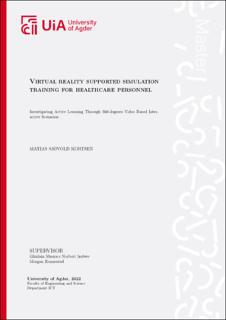| dc.description.abstract | Sørlandet sykehus helseforetak suggested a thesis to design a virtual reality (VR) application with
360-degree videos to be used as an educational tool for training psychiatric healthcare personnel in
handling aggressive and suicidal patients. This study aims to find the advantages of using interactive
VR scenarios as a supplement to simulation training by developing an application using humancentred design. The article explores how an educational VR application can be designed using
human-centred design, the advantages and challenges of using it as a tool for learning, and nurses’
satisfaction with the application.
Simulation training is used in healthcare education and training because it allows participants to
actively train in challenging situations while remaining in a safe environment. However, because of
the time investment and organisational constraints related to simulation training, the use of VR as
a possible supplement is currently being researched and explored by Norwegian hospitals.
The present research study utilised a mixed-method approach comprised of the usability testing
method, combining observations and interviews, and a survey to answer the research questions. The
observations and interviews mainly focused on exploring the design, advantages, and challenges of
the application in healthcare training. The survey focused on exploring satisfaction levels. This
resulted in two interactive VR scenarios that train psychiatric healthcare personnel in handling
a suicidal patients and threats from an aggressive patients.The application was developed using
Premiere Pro, Audition, and Unity, which resulted in an active learning environment where users
directly affect the outcomes of scenarios.
The advantages of the application are related to its affordability, its use as a learning tool for
experiential and affective learning, and its use as a mediator for peer learning. The disadvantages
of the application are related to the immersion of experienced healthcare personnel in the topics,
the time investment for developing such an application, and the fact that it may not adequately
sufficiently replace physical scenarios. Lastly, the application was satisfying based on the healthcare
workers’ responses.
Future research could explore the research’s advantages and challenges in depth to re-evaluate their
importance in healthcare training or in other fields. For example, future research could directly
test interactive VR simulations in simulation training or test whether it promotes peer learning.
Exploring interactive VR scenarios in different cultures and professions could also result in different
satisfaction levels. | |
